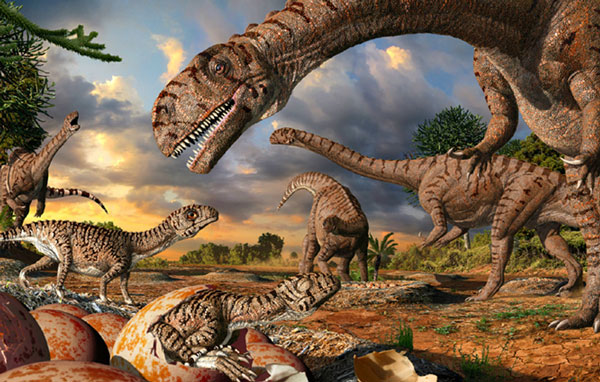Why do giant dinosaurs give birth to babies?
A new study may explain some of the mysteries of dinosaurs, such as why giant animals give birth to tiny babies, why dinosaurs don't fly again, and why birds today fly.
Research published in Biology Letters explains how birds and mammals can survive the extinction period 65.5 million years ago. Huge body size and dinosaur egg laying can play an important role.
'The most successful dinosaurs are the big ones that have the advantage in competing with species. After mass extinction, they tried to reach a large size, but in order to prevail in the competition of species, they must reach a ton weight , " said Daryl Codron, the lead author of the study. .
Because giant adult dinosaurs tend to defeat medium-sized adults, along with the fact that they cannot lay large eggs, most dinosaurs are either very small or very large. Other mammals fill the void in the ecosystem with average body size.
The catastrophic extinction of 65.5 million years ago destroyed the giant dinosaurs, then few dinosaurs survived to fill the gap in the food chain. Mammals multiply, and non-bird dinosaurs have disappeared.
This theory may explain why dinosaurs are living today - ie birds - can survive and develop their flying abilities.

Dinosaurs are not absolutely dominant species
in the battle of competition. (Source: Discovery)
'Many people think that dinosaurs are outstanding competitors, but there is evidence that mammals have proliferated during the dinosaurs, although mammals may have eaten baby dinosaurs. or dinosaur eggs , " Codron said.
Therefore, 'our research results can help explain the evolution to flight. Small dinosaurs need to find space in the ecosystem to avoid mammals because they have to compete with each other and compete with mammals. '
Christine Janis, Brown University professor of biology, said that the fossil stomach of Repenomamus, the largest mammal in white powder, contains an immature dinosaur.
'The truth is that all dinosaurs have to go through a relatively independent period of immaturity and have to compete with mammals. This may affect population recovery results after mass extinction, " Janis said.
It seems that in all mammals at the time, birds could not be larger.
Giant mammals that give birth to babies are also very large, but dinosaurs have limitations in laying eggs. This means that dinosaurs weighing up to 150 tons only produce relatively small eggs.
'They can't lay eggs big because then the eggshell will be thin, making the egg easily broken or losing the embryo's oxygen in the egg. It is fine for small spawning animals, but large animals must also lay relatively small eggs to ensure safety. "
- Sharks give birth without males
- Strange findings - sharks give birth to babies without a father
- Baby robots encourage women to give birth to babies
- Giant dinosaurs dug out of the cave
- It is possible to give birth without a mother's egg
- Low birth weight babies are more likely to suffer from depression
- Why is the old father easy to give birth to malformed children?
- The old father easily gave birth to a bad boy
- What do you know about reproductive health?
- Women give birth for the first time, can they give birth twice?
- 70 million years old dinosaurs
- Video: Fishermen help sharks give birth to babies
 Animal 'suffering' after hibernation
Animal 'suffering' after hibernation Why do goats climb well?
Why do goats climb well? Scientists were surprised to see chimpanzees eating turtles
Scientists were surprised to see chimpanzees eating turtles Giant catfish died deadly due to drought in Thailand
Giant catfish died deadly due to drought in Thailand